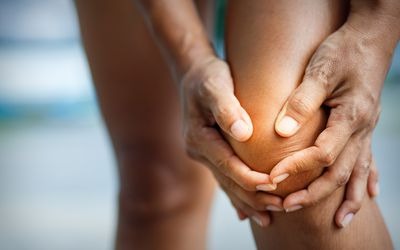Complementary and Alternative Medicine for Patients with Rheumatoid Arthritis
Rheumatoid Arthritis (RA) is a long-lasting inflammatory autoimmune disease that affects joints and connective tissue, often causing pain and disability. It requires ongoing pharmacological treatment to manage symptoms. RA can occur at any age but is typically diagnosed between 30 and 50 years old. Common comorbidities include cardiovascular disease, muscle wasting, depression, and a reduction in overall quality of life (1;2). While drugs have significantly improved the management of RA, they can also have notable side effects.
Given these challenges, individuals with RA often explore Complementary and Alternative Medicine (CAM) for additional relief. Joint pain and arthritis rank among the top five reasons Americans seek CAM (3). Typically, CAM is used alongside standard medical treatment to alleviate disease symptoms and mitigate drug side effects. Here, we provide an overview of the existing research on commonly used treatments by RA patients, as well as a summary of potentially safe and effective options for this population.
Dietary and Botanical Supplements
Fish oil:
Fish oil is frequently mentioned when working with RA patients. The typical Western diet lacks omega-3 essential fatty acids (EFAs), which are believed to possess anti-inflammatory properties. Fish oil contains two EFAs, eicosapentaenoic acid (EPA) and docosahexaenoic acid (DHA). While the body can convert EPA to DHA, the efficiency of this conversion varies among individuals. Plant-based sources like flax and algae also provide EPA and DHA, respectively. The National Center for Complementary and Alternative Medicine (NCCAM) within the National Institutes of Health (NIH) reported promising evidence for the use of fish oil or other omega-3 supplements in the treatment of RA, based on laboratory, animal, and clinical studies (4). Some benefits have been observed for symptoms such as joint tenderness, morning stiffness, and the use of non-steroidal anti-inflammatory drugs (NSAIDs). However, the extent to which these effects can be attributed to the placebo effect remains uncertain, as findings from randomized controlled trials (RCTs) are inconsistent.
To ensure long-term speed and performance improvement, it is important for patients to exercise caution when using fish oil. This is because it can reduce clotting ability, increasing the risk of bleeding. Particularly, individuals taking blood thinners, blood pressure medication, or anticipating surgery should take extra care. Additionally, concentrated fish extract also carries a certain amount of risk due to potential mercury contamination. Unfortunately, dietary and herbal supplements are not regulated by the FDA, making it difficult to determine mercury levels without thorough research on the manufacturer. Label accuracy also cannot be guaranteed, raising concerns about the supplement’s ingredients and potential unknown additives.
Another type of fatty acid called Gamma Linolenic Acid (GLA) differs from EPA and DHA as it is an omega-6 fatty acid. Although the standard western diet contains higher levels of omega-6 fats, which are associated with inflammation, there is strong evidence suggesting the anti-inflammatory properties of GLA. While it is not naturally found in the diet, it can be sourced from various plant seeds such as borage, evening primrose, and black currant. A comprehensive review conducted by the reputable Cochrane Collaboration in 2000 explored multiple randomized controlled trials (RCTs) that indicated the beneficial effects of GLA on pain, joint tenderness, and morning stiffness.
However, it is important to consider the potential risks of drug interactions associated with supplements. Borage oil may contain harmful pyrrolizidine alkaloids that can adversely affect the liver. The risk of bleeding with GLA is similar to that of fish oil. Evening primrose should not be taken concurrently with certain psychiatric drugs (phenothiazines), and there is a potential for minor gastrointestinal side effects (nausea, gas, bloating, etc.) with large quantities of these supplements.
Glucosamine and chondroitin.
Glucosamine and chondroitin are two distinct substances that are often combined in supplement form. While they can be derived from shellfish, they are also naturally present in human joint tissue. Typically used for osteoarthritis (OA), a degenerative form of arthritis with a different cause from RA, these supplements have shown anti-inflammatory effects in animal studies. However, clinical trials have been inconsistent and controversial, with some reporting improvements on X-ray, others noting symptom relief only, and still others finding no effect. Nevertheless, there is no evidence to suggest that these supplements are beneficial for RA patients.
Although glucosamine and chondroitin are generally safe, they may pose risks for individuals with asthma, diabetes, blood clotting disorders, or shellfish allergies. Mild gastrointestinal symptoms may also occur.
Turmeric, ginger, and valerian are three supplements believed to possess anti-inflammatory properties. Turmeric, containing curcumin, has been associated with reduced inflammation in animals, and a small double-blind crossover trial found improvements in walking time, swelling, and morning stiffness for RA patients. Similarly, a trial found that a ginger supplement was linked to decreased pain and discomfort in RA patients. Valerian root, commonly used as a sleep aid due to its relaxing properties, may be helpful for RA patients, who often experience poor sleep. However, there is a lack of research evidence on its effectiveness for this population. It is important to avoid combining valerian with sedatives or other sleep aids.
Regarding special diets, one’s dietary choices can significantly impact health promotion, considering the complexities of a chronic condition. For individuals diagnosed with RA, dietary decisions have added significance for various reasons. It may be challenging to maintain a well-balanced diet, drug therapy could affect nutrient absorption, and foods perceived as allergens might contribute to inflammation. While all individuals, especially those with RA, should strive to consume a nutrient-dense, well-balanced diet with limited additives and processed foods, certain special diets have been specifically investigated for their potential to assist RA patients.
Fasting/Elimination
For individuals with RA, a short period of fasting could offer temporary relief by eliminating potential allergenic foods (10). However, it’s important to note that such effects may not be long-lasting, and symptoms might reappear upon resuming a normal diet (11). It is crucial to approach fasting with caution and under close medical supervision. Resuming a regular diet while excluding sensitive foods may lead to more enduring effects. It’s worth mentioning that certain RA patients exhibit a high sensitivity to specific foods, and eliminating these ingredients can prove beneficial (12). Nonetheless, it’s important to highlight that there is no scientific evidence supporting the notion that RA is caused by food allergies or other substances.
Vegetarian/Vegan
European trials have explored the efficacy of vegan (no animal products) or vegetarian (includes eggs and dairy) diets for RA patients, often after a fasting period. These studies have demonstrated certain benefits, such as reduced inflammation, lower disease activity, and decreased pain and stiffness. However, tolerating these diets may pose challenges, resulting in a relatively high dropout rate (13).
Mediterranean
A randomized controlled trial (RCT) focusing on a Mediterranean diet revealed improvements in clinical and psychological aspects among RA patients (14). Two other observational trials are currently in progress, which will hopefully provide further insights into this area.
Acupuncture
According to a Cochrane review, only one clinical trial on acupuncture met the rigorous inclusion criteria for study design (15). The results did not show any statistically significant differences between the intervention and control groups. A previous review encompassed a broader range of studies but yielded mixed results, leading to the conclusion that no firm conclusions could be drawn from the conducted trials thus far in this realm (6). Although there may be some alleviation of symptoms, additional research is required to obtain a clearer understanding of acupuncture’s effectiveness for RA.
Magnets
Many arthritis patients turn to magnets for complementary pain treatment. A review of magnet use for pain cites a trial in RA patients experiencing relentless knee pain (16), showcasing significant pain reduction with two different types of magnetic treatment. However, a third group without magnetic treatment for comparison was absent. Although magnets have shown effectiveness in treating other types of pain (17), further research is needed to ensure their safety and efficacy specifically for the RA population.
Hydrotherapy
In 2008, Verhagen et al. conducted a Cochrane review, examining seven trials of hydrotherapy (also known as balneotherapy) in RA patients. These trials typically involved mineral baths with varying minerals and concentrations. It is important to differentiate this from water aerobics or other physical therapy water treatments, as they are not considered complementary and alternative medicine (CAM). Most studies reported positive outcomes, but methodological flaws hindered conclusive results. Pain and quality of life (QOL) showed mixed improvements, while some studies noted enhancements in morning stiffness and grip strength. Many studies were underpowered or lacked sufficient data to determine statistically significant differences. Although hydrotherapy may offer benefits to RA patients, a large and well-conducted trial is warranted.
Homeopathy
Homeopathy is based on the principle of “like cures like.” Substances that cause certain symptoms in larger quantities are diluted to the extent that they may relieve those same symptoms. Two recent trials compared homeopathy to a placebo for RA patients (19; 20), but neither found evidence of its effectiveness. An RCT in 1980 showed improvements in pain, stiffness, and grip strength for the treatment group, but not for controls (21). However, a pilot study conducted two years prior couldn’t draw conclusions due to the confounding effects of pharmaceuticals and non-specific aspects of physician interaction (22).
Overall, the available evidence does not support the use of homeopathy for RA. Larger and better-designed studies are required to solidify this conclusion.
General Recommendations
The realm of complementary and alternative medicine (CAM) encompasses a wide range of therapies, including mind-body techniques, herbal remedies, energy medicine, and other non-conventional modalities that diverge from traditional medical care. It’s worth noting that certain CAM treatments, like certain vitamin and mineral supplements, have transitioned into mainstream healthcare. Due to the heterogeneous nature of CAM, it is not appropriate to draw sweeping conclusions about its overall effectiveness. However, certain CAM modalities hold promise for individuals living with rheumatoid arthritis (RA). Natural supplements with anti-inflammatory properties and well-tolerated side effects may offer benefits. Moreover, special diets that adequately meet nutritional requirements may also provide relief. Additionally, CAM activities that promote physical movement appear to be particularly favorable, as increased activity levels offer advantages for this population. Overall, CAM approaches that help patients relax, manage physical and emotional stress, and improve balance can be beneficial through various mechanisms. As this is still an emerging field, further research is needed to strengthen these findings.
For the ongoing management of rheumatoid arthritis, various lifestyle recommendations are widely accepted. These include: 1) maintaining a nutritious and well-rounded diet, 2) engaging in regular physical activity, 3) reducing sources of stress and implementing stress management strategies, 4) seeking social support, 5) fostering open communication with healthcare providers, and 6) actively participating in disease management. Given the complex nature of systemic autoimmune diseases, such as RA, it is crucial to address all aspects of an individual’s well-being, beyond pharmacotherapy alone. The science of psychoneuroimmunology suggests that immune function is influenced by a multitude of factors that warrant comprehensive consideration.
Overall Recommendations
Complementary and alternative medicine (CAM) encompasses a wide range of therapies, including mind-body techniques, herbal remedies, energy medicine, and other approaches not considered part of standard allopathic care. It’s worth noting that certain CAM treatments that were once considered alternative have now transitioned into mainstream care, such as specific vitamin and mineral supplementation. Due to the diverse nature of CAM, making generalized conclusions about its overall effectiveness would be inappropriate. However, some CAM modalities show promising outcomes for individuals living with RA. Certain natural supplements, known for their anti-inflammatory properties, may be beneficial when side effects are minimal. Special diets, if nutritionally adequate and acceptable to the patient, might also offer relief. CAM-based physical activities hold particular promise, as they can safely boost activity levels for this population. Overall, CAM approaches that promote relaxation, stress reduction, and emotional balance can prove beneficial through various mechanisms. As expected in this evolving scientific field, further research is warranted to substantiate these findings.
While these aspects of lifestyle may not fit the traditional CAM label, they encourage active involvement in disease management and often address stress, provide social support, or promote healthier choices like diet and exercise. For those interventions that pose no harm, potential benefits may extend beyond what can be objectively measured or evaluated using current criteria. In many cases, more research is needed to provide recommendations about participation or avoidance. It is crucial for both patients and healthcare providers to be well-informed about the nature of these modalities, while researchers and funding bodies continue to explore their safety, effectiveness, and underlying mechanisms.
Medical Research by
Steffany Haaz, MFA, CYT
Reference List
- Walsmith J, Roubenoff R. Cachexia in rheumatoid arthritis. Int J Cardiol 2002; 85(1):89-99.
- Bair MJ, Robinson RL, Katon W, Kroenke K. Depression and pain comorbidity: a literature review. Arch Intern Med 2003; 163(20):2433-2445.
- Barnes PM, Powell-Griner E, McFann K, Nahin RL. Complementary and alternative medicine use among adults: United States, 2002. Adv Data 2004;(343):1-19.
- National Center for Complementary and Alternative Medicine. Research Report: Rheumatoid Arthritis and Complementary and Alternative Medicine. http://nccam.nih.gov/health/RA/ [ 2008 [cited 2008 Feb. 17];
- Little C, Parsons T. Herbal therapy for treating rheumatoid arthritis. Cochrane Database Syst Rev 2001;(1):CD002948.
- Soeken KL. Selected CAM therapies for arthritis-related pain: the evidence from systematic reviews. Clin J Pain 2004; 20(1):13-18.
- Distler J, Anguelouch A. Evidence-based practice: review of clinical evidence on the efficacy of glucosamine and chondroitin in the treatment of osteoarthritis. J Am Acad Nurse Pract 2006; 18(10):487-493.
- Ahmed S, Anuntiyo J, Malemud CJ, Haqqi TM. Biological basis for the use of botanicals in osteoarthritis and rheumatoid arthritis: a review. Evid Based Complement Alternat Med 2005; 2(3):301-308.
- Srivastava KC, Mustafa T. Ginger (Zingiber officinale) in rheumatism and musculoskeletal disorders. Med Hypotheses 1992; 39(4):342-348.
- Palmblad J, Hafstrom I, Ringertz B. Antirheumatic effects of fasting. Rheum Dis Clin North Am 1991; 17(2):351-362.
- Kjeldsen-Kragh J, Haugen M, Borchgrevink CF, Laerum E, Eek M, Mowinkel P et al. Controlled trial of fasting and one-year vegetarian diet in rheumatoid arthritis. Lancet 1991; 338(8772):899-902.
- Darlington LG, Ramsey NW. Review of dietary therapy for rheumatoid arthritis. Br J Rheumatol 1993; 32(6):507-514.
- Stamp LK, James MJ, Cleland LG. Diet and rheumatoid arthritis: a review of the literature. Semin Arthritis Rheum 2005; 35(2):77-94.
- Skoldstam L, Hagfors L, Johansson G. An experimental study of a Mediterranean diet intervention for patients with rheumatoid arthritis. Ann Rheum Dis 2003; 62(3):208-214.
- Casimiro L, Barnsley L, Brosseau L, Milne S, Robinson VA, Tugwell P et al. Acupuncture and electroacupuncture for the treatment of rheumatoid arthritis. Cochrane Database Syst Rev 2005;(4):CD003788.
- Segal NA, Toda Y, Huston J, Saeki Y, Shimizu M, Fuchs H et al. Two configurations of static magnetic fields for treating rheumatoid arthritis of the knee: a double-blind clinical trial. Arch Phys Med Rehabil 2001; 82(10):1453-1460.
- Eccles NK. A critical review of randomized controlled trials of static magnets for pain relief. J Altern Complement Med 2005; 11(3):495-509.
- Verhagen AP, Bierma-Zeinstra SM, Boers M, Cardoso JR, Lambeck J, de Bie RA et al. Balneotherapy for osteoarthritis. Cochrane Database Syst Rev 2007;(4):CD006864.
- Andrade LE, Ferraz MB, Atra E, Castro A, Silva MS. A randomized controlled trial to evaluate the effectiveness of homeopathy in rheumatoid arthritis. Scand J Rheumatol 1991; 20(3):204-208.
- Fisher P, Scott DL. A randomized controlled trial of homeopathy in rheumatoid arthritis. Rheumatology (Oxford) 2001; 40(9):1052-1055.
- Gibson RG, Gibson SL, MacNeill AD, Buchanan WW. Homoeopathic therapy in rheumatoid arthritis: evaluation by double-blind clinical therapeutic trial. Br J Clin Pharmacol 1980; 9(5):453-459.
- Gibson RG, Gibson SL, MacNeill AD, Gray GH, Dick WC, Buchanan WW. Salicylates and homoeopathy in rheumatoid arthritis: preliminary observations. Br J Clin Pharmacol 1978; 6(5):391-395.
- Lee MS, Pittler MH, Ernst E. Tai chi for rheumatoid arthritis: systematic review. Rheumatology (Oxford) 2007; 46(11):1648-1651.
- Dash M, Telles S. Improvement in hand grip strength in normal volunteers and rheumatoid arthritis patients following yoga training. Indian J Physiol Pharmacol 2001; 45(3):355-360.
- Haslock I, Monro R, Nagarathna R, Nagendra HR, Raghuram NV. Measuring the effects of yoga in rheumatoid arthritis. Br J Rheumatol 1994; 33(8):787-788.
- Haaz S, Bathon J, Bartlett S. Initial Findings of an RCT of Yoga on Physical and Psychological Functioning in RA and OA. Arthritis and Rheumatism Supplement. 2007.
Ref Type: Abstract
To See the Full Research Report
Visit Johns Hopkins Arthritis Center – Complementary and Alternative Medicine for Patients with Rheumatoid Arthritis.










